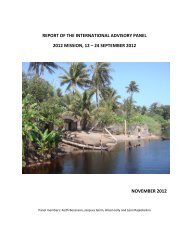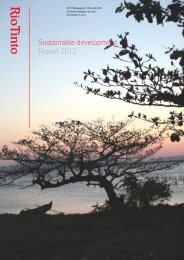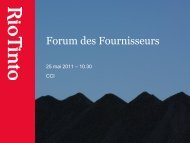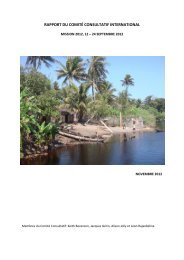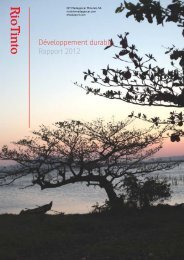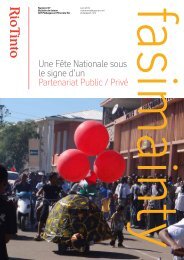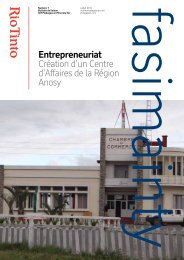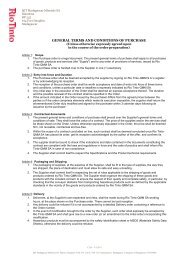Download PDF [ 145 KB ] - Rio Tinto - Qit Madagascar Minerals
Download PDF [ 145 KB ] - Rio Tinto - Qit Madagascar Minerals
Download PDF [ 145 KB ] - Rio Tinto - Qit Madagascar Minerals
Create successful ePaper yourself
Turn your PDF publications into a flip-book with our unique Google optimized e-Paper software.
07_<strong>Madagascar</strong>Revisions_R4 3/7/08 3:38 PM Page 155<br />
Chapter 4.2<br />
An Inventory of the Mantodea and Phasmatodea in the<br />
Littoral Forests near Tolagnaro (Fort-Dauphin)<br />
Kai Schütte<br />
Abstract<br />
Eleven species of Mantodea and 11 species of<br />
Phasmatodea were recorded in the littoral forests of<br />
Petriky, Mandena, and Sainte Luce near Tolagnaro.<br />
Two genera and at least six species of Phasmatodea,<br />
and one genus and three species of Mantodea are<br />
new to science. The identification and descriptions<br />
of these new species are in progress.<br />
Résumé<br />
Inventaire des Mantodea et des Phasmatodea<br />
dans les forêts littorales des environs de<br />
Tolagnaro (Fort-Dauphin). Onze espèces de<br />
Mantodea et 11 espèces de Phasmatodea ont été<br />
inventoriées dans les forêts littorales de Petriky,<br />
Mandena et Sainte Luce près de Tolagnaro. Deux<br />
genres et au moins six espèces de Phasmatodea ainsi<br />
qu’un genre et trois espèces de Mantodea sont de<br />
nouveaux taxons pour la science. L’identification et<br />
les descriptions de ces nouvelles espèces sont en<br />
cours.<br />
Introduction<br />
The study of Mantodea from <strong>Madagascar</strong> started in<br />
1839 with Serville who described the first species. It<br />
continued with the work of Bates (1863), Saussure<br />
(1870), Brancsik (1893, 1895), and Westwood<br />
(1889) when each described a new species. The first<br />
monograph work of Malagasy Mantodea by<br />
Saussure and Zehntner (1895) provided a list of 36<br />
species, half of them described as new. Over the next<br />
50 years, several authors described single species of<br />
Mantodea found on the island (e.g., Saussure 1899,<br />
Lamberton 1911, Giglio-Tos 1912, 1913, 1915,<br />
Beier 1929, 1935a, 1935b, Sjöstedt 1930).<br />
The only relatively recent comprehensive treatment<br />
of the Mantodea fauna of <strong>Madagascar</strong> is that of<br />
Paulian (1957). Of the 52 species presented in that<br />
work, four were new to science and 88% were listed<br />
as endemic. A few previously published records of<br />
Malagasy Mantodea were excluded from the work of<br />
Paulian, as he was doubtful of their presence on the<br />
island. In the second half of the twentieth century, a<br />
few new species were described (Paulian 1957,<br />
1958, 1961), and Roy (1987) listed a total of 54<br />
species of Mantodea on the island. More recently,<br />
work has been done to revise several genera and to<br />
describe new genera and species (Roy 1989, 2004,<br />
2005, Mériguet 2005). Revisions of Tarachomantis<br />
and of several genera of the Tarachodidae and<br />
Iridopterygidae are currently being prepared (R.<br />
Roy, pers. comm.).<br />
Until recently, the Phasmatodea of <strong>Madagascar</strong> has<br />
been almost completely neglected by entomologists,<br />
in spite of the fact that they are some of the largest and<br />
most colorful insects found on the island. No monograph<br />
or summary article had been written about the<br />
Malagasy members of this order until the recent publication<br />
of a preliminary checklist of type specimens<br />
(Cliquennois 2003). Since the taxonomy and systematic<br />
position of many species is currently uncertain, a<br />
lot of field and museum research still needs to be<br />
done. There is a large number of species in museum<br />
collections that remain undescribed. Unfortunately,<br />
some type specimens have been lost or destroyed like<br />
those in the Hungarian Museum, Budapest, by a fire in<br />
1956. This considerably complicates taxonomic<br />
research. In such cases, the type localities should be<br />
revisited in order to collect more specimens of a given<br />
taxon, especially when specimens are not known to be<br />
present in other museum collections, and where the<br />
Department of Animal Ecology and Conservation,<br />
Hamburg University, Martin-Luther-King Platz 3, 20146<br />
Hamburg, Germany. Email: kai_Schuette@public.unihamburg.de<br />
SI/MAB Series 11 ■ 155
07_<strong>Madagascar</strong>Revisions_R4 3/7/08 3:38 PM Page 156<br />
original species descriptions are inadequate to properly<br />
diagnose the species.<br />
The first described, endemic species of<br />
Phasmatodea in <strong>Madagascar</strong> was Achrioptera fallax,<br />
which was named by Coquerel (1861). There<br />
are other Malagasy species that were named earlier,<br />
but their type localities were given as “Maurice” and<br />
“côtes d´Afrique” (Audinet-Serville 1838,<br />
Burmeister 1838). A few other articles were published<br />
in the nineteenth century, which described<br />
endemic Malagasy Phasmatodea (e.g., Wood-<br />
Mason 1879, Kirby 1891, Brancsik 1893, 1897,<br />
Finot 1897). From 1906 to 1908, the three-part<br />
monograph “Die Insektenfamilie der Phasmiden”<br />
(Redtenbacher 1906, 1908, Brunner von Wattenwyl<br />
1907) described 52 new species. The only other<br />
twentieth century publications that described new<br />
taxa were Carl (1913), Chopard (1919, 1952), and<br />
Rehn (1940). Recently, several authors have continued<br />
work on the Malagasy Phasmatodea<br />
(Hennemann and Conle 2004, Zompro 2004,<br />
Cliquennois 2005). The most comprehensive study<br />
is being undertaken by Nicolas Cliquennois. At<br />
present, about 80 species have been named, but further<br />
research is likely to double that number.<br />
Methods<br />
During a field study from October to December 2000,<br />
Mantodea and Phasmatodea were collected from transects<br />
in Petriky, Mandena, and Sainte Luce using a<br />
beating tray (Ozanne 2005, Fig. 1). Further, general<br />
collections of these two orders were carried out from<br />
February to May 2004, and from October 2004 to<br />
May 2005. The collecting effort was different in each<br />
forest: Petriky - 5 days in October 2000 and 2 days in<br />
April 2004; Mandena (fragment M13, M15, and<br />
M16) - several weeks in 2000, 2004, and 2005; and<br />
Sainte Luce (fragment S9) - several weeks in 2000,<br />
2004, and 2005. Since the phytophagous<br />
Phasmatodea are nocturnal and generally hide on bark<br />
or branches during the day, the majority of specimens<br />
were collected during the night when they were feeding<br />
on leaves. For the predatory Mantodea, which feed<br />
on both diurnal and nocturnal invertebrates,<br />
collections were done both during the day and night.<br />
Figure 1. Overview of study sites for the inventory of Mantodea and Phasmatodea.<br />
156 ■ Biodiversity, Ecology and Conservation of Littoral Ecosystems in Southeastern <strong>Madagascar</strong>, Tolagnaro
07_<strong>Madagascar</strong>Revisions_R4 3/7/08 3:38 PM Page 157<br />
Table 1. Distribution of Mantodea in the coastal forests of Tolagnaro.<br />
Taxa Petriky Mandena Sainte Luce<br />
Hymenopodidae<br />
Phyllocrania paradoxa +<br />
Tarachodidae<br />
Nesogalepsus sp. + +<br />
“Tarachodinae” sp. +<br />
Thespidae<br />
Apterocorypha sp. +<br />
Iridopterygidae<br />
Platycalymma sp. +<br />
Mantidae<br />
Tarachomantis sp. + + +<br />
Tisma freyi +<br />
Tisma pauliani + +<br />
Popa spurca cf. spurca + +<br />
Danuriella irregularis +<br />
Brancsikia aeroplana +<br />
Voucher specimens of the Mantodea were preserved<br />
in alcohol for some months, and then pinned<br />
and dried. Phasmatodea were preserved in propanol<br />
and prepared as described by Zompro (1996).<br />
Results and Discussion<br />
Mantodea<br />
The material collected in 2000, 2004, and 2005 in<br />
the costal forests of Petriky, Mandena, and Sainte<br />
Luce comprises 11 species of Mantodea (Table 1).<br />
Eight genera and nine species are endemic to<br />
<strong>Madagascar</strong>. The systematic classification follows<br />
Ehrmann (2002).<br />
Family Hymenopodidae<br />
Phyllocrania paradoxa Burmeister, 1838. Also<br />
described from <strong>Madagascar</strong> as P. illudens Saussure<br />
and Zehntner 1895, and synonomized by Roy<br />
(1963). This species is also widely distributed in sub-<br />
Saharan Africa.<br />
Family Tarachodidae<br />
Nesogalepsus sp. Seven species of this endemic<br />
genus have been described, and are distributed<br />
across the island. A revision is in progress that will<br />
split the genus, and the number of species will<br />
increase (R. Roy, pers. comm.).<br />
“Tarachodini” sp. A single male was found in<br />
November 2004 in the littoral forest of Sainte Luce.<br />
This new species also belongs to a new genus. Four<br />
specimens of three other species of this genus are<br />
known from the collections of the Muséum national<br />
d´Histoire naturelle (MNHN), Paris, and the<br />
California Academy of Science (CAS). These specimens<br />
were collected in eastern <strong>Madagascar</strong> at<br />
Beparasy near Moramanga, on the Masoala<br />
Peninsula, and in the Ampasindava Forest in the far<br />
north.<br />
Family Thespidae<br />
Apterocorypha sp. The two species of this genus are<br />
found in portions of southeastern <strong>Madagascar</strong>.<br />
Further examination of the types, and the collection<br />
of specimens from different localities are necessary<br />
to confirm the identity of the specimens collected<br />
during these inventories.<br />
Family Iridopterygidae<br />
Platycalymma sp. Only one specimen was observed<br />
in the degraded southern part of the forest fragment<br />
S9 of Sainte Luce, and it was not collected.<br />
Family Mantidae<br />
Tarachomantis sp. A revision is in progress, eight<br />
species are known and the genus is distributed all<br />
over the island. Mériguet (2005) already separated<br />
the genus Mantasoa from Tarachomantis, from<br />
which he transferred M. macula (Saussure and<br />
Zehntner 1895) and described M. lebbei.<br />
SI/MAB Series 11 ■ 157
07_<strong>Madagascar</strong>Revisions_R4 3/7/08 3:38 PM Page 158<br />
Tisma freyi Brancsik, 1893. A recent revision<br />
described three new species (Roy 2005), including T.<br />
pauliani. At present five species of the genus Tisma<br />
are described. Comparing ootheca with the known<br />
species of this genus, has led to the possibility that at<br />
least one more species exists.<br />
Popa spurca cf. spurca Stal, 1856. This species is<br />
also found in sub-Saharan Africa. Several species,<br />
which are highly variable and difficult to distinguish,<br />
are known. A revision of material from the mainland<br />
of Africa has shown that only one species with two<br />
subspecies exists (Lombardo 1995).<br />
Danuriella irregularis Westwood, 1889. Three<br />
species of this endemic genus are described, but several<br />
other species are known. A revision by R. Roy is<br />
in progress.<br />
Brancsikia aeroplana Lamberton, 1911. This forest<br />
species has one generation per year and a wide<br />
distribution from the humid coastal and montane<br />
forests in Andasibe, south to near Tolagnaro. It was<br />
found in one of the Sainte Luce forest fragments.<br />
Phasmatodea<br />
The studied material comprises nine species of<br />
Phasmantodea (Table 2), of which at least six species<br />
and two genera are new to science. Field research<br />
has found that some of these species also occur in<br />
the nearby montane forests, but further exploration is<br />
necessary to determine the distribution of these new<br />
species. The systematic classification follows<br />
Bradley and Galil (1977) and Zompro (2004).<br />
Areolatae<br />
Antongiliinae<br />
“Antongiliinae” sp. Nine genera of Malagasy<br />
Antongiliinae are described. The species collected in<br />
Sainte Luce do not correspond with any of them. An<br />
extensive revision is required. One part of a revision<br />
by Cliquennois (2006) is completed, and the other<br />
part is in progress.<br />
Cirsia sp. This new species belongs to the genus<br />
Cirsia, which contains three species. Both sexes<br />
were found.<br />
Leprodes dicranocollis Redtenbacher, 1906.<br />
Females and the yet undescribed males were collected.<br />
This species is also known from Isaka-Ivondro to<br />
the northwest of Tolagnaro. The other species originally<br />
described in this genus, L. gibbifer<br />
Redtenbacher, 1906, belongs in a different genus<br />
(N. Cliquennois, pers. comm.).<br />
Pseudodatames sp. Two species were described by<br />
Redtenbacher (1906), and another species, only<br />
known from the female, was recently described by<br />
Zompro (2004). Specimens from Mandena and Sainte<br />
Luce are undescribed, but both sexes were collected.<br />
A comprehensive revision of this genus with new<br />
species included is in progress (N. Cliquennois, pers.<br />
comm.). The male holotype of P. alluaudi<br />
Redtenbacher, 1906 was found in “Sakavalana” about<br />
70 km to the north of Tolagnaro. It should have been<br />
deposited in the MNHN, Paris, but the specimen<br />
could not be located in the collection.<br />
Table 2. Distribution of Phasmatodea in the coastal forests of Tolagnaro. No Phasmatodea were found in Petriky.<br />
Taxa Mandena Sainte Luce<br />
Areolatae<br />
Bacillinae<br />
Antongiliinae<br />
“Antongiliinae” sp. +<br />
Cirsia sp. + +<br />
Leprodres dicranocollis + +<br />
Pseudodatames sp. + +<br />
Anisacanthini<br />
Parectatosoma cf. cervinum +<br />
Leiophasma sp.1 + +<br />
Leiophasma sp.2 + +<br />
“Pseudoleosthenes” irregularis +<br />
Xerantherix sp.1 +<br />
Xerantherix sp.2 +<br />
Anareolatae<br />
“sp.1” + +<br />
158 ■ Biodiversity, Ecology and Conservation of Littoral Ecosystems in Southeastern <strong>Madagascar</strong>, Tolagnaro
07_<strong>Madagascar</strong>Revisions_R4 3/7/08 3:38 PM Page 159<br />
Anisacanthini<br />
Parectatosoma cervinum Redtenbacher, 1906. At<br />
present, seven species are known in this genus.<br />
Leiophasma sp. 1 and sp. 2. Currently, sixteen<br />
species of this genus have been described from<br />
<strong>Madagascar</strong>. Further research and a revision of this<br />
genus are required.<br />
“Pseudoleosthenes” irregularis Redtenbacher,<br />
1906. The collected female specimens match the<br />
holotype housed in the Natural History Museum,<br />
Vienna, Austria. The male was also collected, but is<br />
currently undescribed. The actual placement of this<br />
species requires further research (N. Cliquennois<br />
pers. com.) since its egg structure indicates a close<br />
relationship with Damasippoides albomarginatus<br />
Redtenbacher, 1908.<br />
Xerantherix sp. 1 and sp. 2. Four species have<br />
been described in this genus. The collected species<br />
were very common in parts of the forests of Sainte<br />
Luce and Mandena in November and December, and<br />
both sexes were collected. They belong to two new<br />
forms. Species differences in Xerantherix “sp.1”<br />
from Mandena and “sp. 2” from Sainte Luce are<br />
illustrated by the slight variation in the pronotum of<br />
the male and in the external genitalia of both sexes.<br />
Anareolatae<br />
“Anareolatae” sp. 1. This species does not belong to<br />
any known genus. Only a few specimens of either<br />
sex were collected on herbs near the ground in<br />
Mandena and Sainte Luce.<br />
Acknowledgements<br />
I wish to thank Nicolas Cliquennois, Roger Roy, and<br />
George Beccaloni for their help with the identification<br />
of the Phasmatodea and Mantodea, and for their<br />
comments on the manuscript. I am grateful to Jörg U.<br />
Ganzhorn for permanent support. Ulrike Aspöck<br />
(NHMW) and Christiane Amédéngnato (MNHN)<br />
provided access to the natural history museum collections<br />
of Vienna and Paris, respectively. The paper<br />
is part of the cooperation between the Université<br />
d´Antananarivo, QIT <strong>Madagascar</strong> <strong>Minerals</strong>, and the<br />
University of Hamburg. I thank the Ministère des<br />
Eaux et Forêts and the Committee “CAFF-CORE”<br />
of the Malagasy Government for the permission to<br />
carry out this work. I also thank QIT <strong>Madagascar</strong><br />
<strong>Minerals</strong> and their environmental and conservation<br />
team headed by Manon Vincelette for their support<br />
and logistic help in the field. The project was supported<br />
by the Hamburger Universitätsstiftung and<br />
the German Academic Exchange Service (DAAD).<br />
References<br />
Audinet-Serville, J.G. 1838. Histoire naturelle des<br />
insectes. Orthoptères. Librairie Encyclopédique de<br />
Roret, Paris.<br />
Bates, H.W. 1863. On some insects collected in<br />
<strong>Madagascar</strong> by Mr. Caldwell. Proceedings of the<br />
Zoological Society of London 30:472-480.<br />
Beier, M. 1929. Ein neues Mantiden-Genus aus<br />
Madagaskar. Zoologischer Anzeiger 85:292-294.<br />
Beier, M. 1935a. Genera Insectorum. Mantodea<br />
Subfamilie: Thespinae. Wytsman, Lieferung 200,<br />
Tervuren.<br />
Beier, M. 1935b. Genera Insectorum. Mantodea.<br />
Subfam. Orthoderinae, Choeradodinae,<br />
Deroplatynae. Wytsmann, Lieferung 201, Tervuren.<br />
Bradley, J.C. and B.S. Galil. 1977. The taxonomic<br />
arrangement of the phasmatodea with keys to the<br />
subfamilies and tribes. Proceedings of the<br />
Entomological Society of Washington 79:176-208.<br />
Brancsik, C. 1893. Orthoptera nova africana.<br />
Jahrbuche des naturwissenschaftlichen Vereines des<br />
Trencséner Comitates 15:175-258.<br />
Brancsik, C. 1895. Orthoptera quaedam nova africana<br />
et australica. Jahreshefte des naturwissenschaftlichen<br />
Vereines des Trencséner Comitates<br />
17:243-262.<br />
Brancsik, C. 1897. Series Orthopterorum novorum.<br />
Société Histoire Naturelle Trencsén 19-20:52-71.<br />
Brunner von Wattenwyl, K. 1907. Die Insektenfamilie<br />
der Phasmiden. II. Phasmidae Anareolatae. Verlag<br />
Wilhelm Engelmann, Leipzig.<br />
Burmeister, H.C. 1838. Handbuch der Entomologie, 2.<br />
Berlin.<br />
Carl, T. 1913. Phasmides nouveaux ou peu connus du<br />
Muséum de Genève. Revue Suisse de Zoologie 21:1-<br />
56.<br />
Chopard, L. 1919. Diagnoses d´espèces nouvelles<br />
d´Orthoptères. Bulletin de la Société entomologique<br />
de France 25:153-154.<br />
Chopard, L. 1952. Notes sur les Orthopteroides de<br />
<strong>Madagascar</strong>. Mémoires de l´Institut scientifique de<br />
<strong>Madagascar</strong>, série E:463-482.<br />
Cliquennois, N. 2003. Matériel typique des Phasmes de<br />
<strong>Madagascar</strong> (Insecta, Phasmatodea). Bulletin de<br />
Phyllie 17:3-15.<br />
SI/MAB Series 11 ■ 159
07_<strong>Madagascar</strong>Revisions_R4 3/7/08 3:38 PM Page 160<br />
Cliquennois, N. 2005. Spathomorpha n. gen.: un nouveau<br />
genre de Phasme de <strong>Madagascar</strong><br />
(Phasmatodea, Anareolatae). Bulletin de la Société<br />
entomologique de France 110:113-124.<br />
Cliquennois, N. 2006. Révision partielle des<br />
Antongiliinae fondée sur l´étude des oeufs, comprenant<br />
la définition d´une nouvelle tribu et de quatre<br />
nouveaux genres (Phasmatodea). Bulletin de la<br />
Société entomologique de France 111:157-172.<br />
Cocquerel, C. 1861. Orthoptères de Bourbon et de<br />
<strong>Madagascar</strong>. Annales de la Société Entomologique<br />
de France 4:495-499.<br />
Ehrmann, R. 2002. Mantodea, Gottesanbeterinnen der<br />
Welt. Natur und Tier Verlag, Münster.<br />
Finot, A. 1897. Description d´un Phasme nouveau du<br />
genre Parectatosoma Wood-Mason. Annales de la<br />
Société Entomologique de France 66:585-588.<br />
Giglio-Tos, E. 1912. Mantidi esotici. V.- Mantis-<br />
Tenodera- Hierodula- Rhombodera. Bullettino della<br />
Società Entomologica Italiana 43:3-167.<br />
Giglio-Tos, E. 1913. Genera Insectorum. Orthoptera.<br />
Fam. Mantidae. Subfam. Perlamantinae. Wytsman<br />
Lieferung 144:13 pp. Tervuren.<br />
Giglio-Tos, E. 1915. Mantidi esotici. Generi e specie<br />
nuove. Bullettino della Società Entomologica<br />
Italiana 46:31-108.<br />
Hennemann, F.H. and O.V. Conle. 2004. Revison of the<br />
genus Achrioptera Coquerel, 1861, with the description<br />
of two new species from <strong>Madagascar</strong><br />
(Phasmatodea; Anareolatae; Phasmatidae;<br />
Phasmatinae; Achriopterini). Münchner<br />
Entomologische Gesellschaft 94:5-54.<br />
Kirby, W.F. 1891. On the Phasmidae of <strong>Madagascar</strong><br />
with the description of a new genus and species in<br />
the collection of the British Museum. Annals and<br />
Magazine of Natural History 6:150-152.<br />
Lamberton, C. 1911. Description d´une nouvelle espèce<br />
de Brancsikia [Orth. Mantidae]. Insecta 1:1-4.<br />
Lombardo, F. 1995. A review of the genus Popa Stal<br />
1856 (Insecta Mantodea). Tropical Zoology<br />
8:257-267.<br />
Mériguet, B. 2005. Mantasoa, nouveau genre de Mante<br />
endémique à <strong>Madagascar</strong> proche de Tarachomantis<br />
Brancsik (Dictyoptera, Mantidae). Bulletin de la<br />
Société entomologique de France 110:43-46.<br />
Ozanne, C.M.P. 2005. Sampling methods for forest<br />
understory vegetation. Pp. 58-76 in: Leather, S., ed.,<br />
Insect Sampling in Forest Ecosystems. Blackwell<br />
Publishing, Malden, Oxford and Carlton.<br />
Paulian, R. 1957. Faune de <strong>Madagascar</strong>. V. Insectes<br />
Mantodea. Publication de l´Institut de Recherche<br />
scientifique Tananarive, Tsimbazaza, Tananarive.<br />
Paulian, R. 1958. Mantides malgache nouveaux ou<br />
méconnus. Naturaliste Malgache 10(1-2):31-36.<br />
Paulian, R. 1961. Trois nouveaux Mantides de<br />
<strong>Madagascar</strong>. Bulletin de la Société entomologique de<br />
France 66:162-164.<br />
Redtenbacher, J. 1906. Die Insektenfamilie der<br />
Phasmiden I. Phasmidae Areolatae. Verlag Wilhelm<br />
Engelmann, Leipzig.<br />
Redtenbacher, J. 1908. Die Insektenfamilie der<br />
Phasmiden. III. Phasmidae Anareolatae. Verlag<br />
Wilhelm Engelmann, Leipzig.<br />
Rehn, J.W.H. 1940. A new genus of walking-stick from<br />
<strong>Madagascar</strong> (Orthoptera; Phasmatidae;<br />
Acrophyllinae). Notulae Naturae 65:1-4.<br />
Roy, R. 1963. Dictyoptera Mantodea. Pp. 162-206 in:<br />
IFAN, La Réserve naturelle intégrale du Mont<br />
Nimba, V. Mémoires de l´ Institut francaise de<br />
l´Afrique Noirs 66. Dakar.<br />
Roy, R. 1987. Overview of the biogeography of African<br />
mantides. Pp. 489-495 in: Baccetti ed., Evolutionary<br />
Biology of Orthopteroid Insects. Ellis Horwood Ltd.,<br />
Chichester, England.<br />
Roy, R. 1989. Une nouvelle espèce de Mante<br />
endémique à <strong>Madagascar</strong>. Bulletin de la Société<br />
entomologique de France 94:15-20.<br />
Roy, R. 2004. Réarrangement critiques dans la famille<br />
des Empusidae et relations phylogénétiques<br />
(Dictyoptera, Mantodea). Revue Française<br />
d´Entomologie (N.S.) 26:1-18.<br />
Roy, R. 2005. Révision du genre endémique malgache<br />
Tisma Giglio-Tos (Dictyoptera Mantidae). Bulletin<br />
de la Société entomologique de France 110:47-57.<br />
Saussure, H. 1870. Addition au Système des Mantides.<br />
Mitteilungen der Schweizerischen Entomologischen<br />
Gesellschaft 3:221-244.<br />
Saussure, H. 1899. Orthoptera. in: Voeltzkow,<br />
Wissenschaftliche Ergebnisse der Reisen in<br />
Madagaskar und Ost-Afrika in den Jahren 1889-<br />
1895. Abhandlungen der Senkenbergischen naturforschenden<br />
Gesellschaft 21:569-664.<br />
Saussure, H. and L. Zehntner. 1895. Blattides et<br />
Mantides. Pp. 147-244 in: Grandidier, A. Histoire-<br />
Physique, Naturelle et Politique de <strong>Madagascar</strong>.<br />
Histoire Naturelle des Orthoptère. Histoire Naturelle<br />
23. Paris.<br />
Sjöstedt, Y. 1930. Orthopterentypen im<br />
Naturhistorischen Reichsmuseum zu Stockholm.<br />
Arkiv för Zoologi 21A(32):1-43.<br />
160 ■ Biodiversity, Ecology and Conservation of Littoral Ecosystems in Southeastern <strong>Madagascar</strong>, Tolagnaro
07_<strong>Madagascar</strong>Revisions_R4 3/7/08 3:38 PM Page 161<br />
Westwood, J.O. 1889. Revisio Insectorum Familiae<br />
Mantidarum, speciebus novis aut minus cognitis<br />
descriptis et delineatis. Gurney and Jackson,<br />
London.<br />
Wood-Mason, J. 1879. Preliminary notice of a new<br />
Genus (Parectatosoma) of Phasmidae from<br />
<strong>Madagascar</strong>, with brief descriptions of its two<br />
species. Journal Asiatic Society of Bengal 48:1-2.<br />
Zompro, O. 1996. Zum Sammeln, Transport,<br />
Konservieren und Züchten von Phasmiden.<br />
Entomologische Zeitschrift 106:194-202.<br />
Zompro, O. 2004. Revision of the genera of the<br />
Areolatae, including the status of Timema and<br />
Agathemera (Phasmatodea). Abhandlungen des<br />
Naturwissenschaftlichen Vereins in Hamburg (NF) 37.<br />
SI/MAB Series 11 ■ 161
07_<strong>Madagascar</strong>Revisions_R4 3/7/08 3:38 PM Page 162<br />
162 ■ Biodiversity, Ecology and Conservation of Littoral Ecosystems in Southeastern <strong>Madagascar</strong>, Tolagnaro


![Download PDF [ 145 KB ] - Rio Tinto - Qit Madagascar Minerals](https://img.yumpu.com/24563988/1/500x640/download-pdf-145-kb-rio-tinto-qit-madagascar-minerals.jpg)

